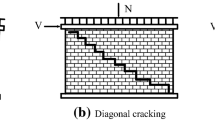Abstract
Masonry is the building of structures from individual units, with or without the use of mortar as a bonding component. Stone masonry structures are frequent in the regions where stones are ubiquitous. In Europe, it was massively used until the nineteenth century to build earth retaining walls. For instance, they represent 85% of the retaining walls in Great Britain and 60% in France. Most of these masonry walls are currently perfectly safe, showing an average durability of more than a century. The best economic interest is to maintain the stock in good order by identifying and repairing the structures at risk of collapse and to preserve the currently satisfactory structures at the lowest investment level. Unfortunately, there is not sufficient scientific knowledge to do so reliably. This work aims to develop a design method suitable for existing structures. The analytical model is based upon the yield design theory which provides a rigorous framework and has proven to be effective for this kind of structures. The strength domain of stone masonry is determined using the homogenization theory. The modelisation is carried out in 2D. An experimental campaign was carried out in order to verify the proposed model. The experimental setup is in 2D thanks to the use of Schneebeli rods and is considered to be a physical model and is not scaled. The theoretical failing load and the theoretical kinematics of the failure are compared with the experimental failing load and the actual kinematics of the failure. The discrepancies and differences between the two sets are then discussed.












Similar content being viewed by others
References
Brady K, Kavanagh J (2002) Analysis of the stability of masonry-faced earth retaining walls. Technical report, Transport Research Foundation
Burgoyne J (1853) Revetments or retaining walls. Corps R Eng Paper 3:154–159
Claxton M, Hart R, McCombie P, Walker P (2005) Rigid block distinct-element model of dry-stone retaining walls in plane strain. J Geotech Geoenviron Eng 131:381–389
Colas A-S (2009) Mécanique des murs de soutènement en pierre sèche : modélisation par le calcul à la rupture et expérimentation échelle 1. PhD thesis, Ecole Centrale de Lyon
Colas A-S, Garnier D, Morel J-C (2013) Yield design modelling of dry joint retaining structures. Constr Build Mater. 41:912–917
Colas A-S, Morel J-C, Garnier D (2008) Yield design of dry-stone masonry retaining structures—comparisons with analytical, numerical and experimental data. Int J Numer Anal Methods Geomech 32:1817–1832
Colas A-S, Morel J-C, Garnier D (2009) 2D modelling of a dry joint masonry wall retaining a pulverulent backfill. Int J Numer Anal Methods Geomech 34:1237–1249
Colas A-S, Morel J-C, Garnier D (2010) Full-scale field trials to assess dry-stone retaining wall stability. Eng Struct 32:1215–1222
De Buhan P, De Felice G (1997) A homogenization approach to the ultimate strength of brick masonry. J Mech Phys Solids 45(7):1085–1104
Gigan J-P (1986) Applications du clouage en soutènement : paramètres de conception et de dimensionnement des ouvrages. Bulletin de Liaison des Laboratoires des Ponts et Chaussées 143:51–64
Hardiyatmo H (1995) Approche expérimentale du dimensionnement des massifs renforcés à parement cellulaire. PhD thesis, Université Joseph Fourier–Grenoble 1
Le H H (2013) Stabilité des murs de soutènement routiers en pierre sèche : Modélisation 3D par le calcul à la rupture et expérimentation échelle 1. PhD thesis, ENTPE
Le HH, Morel J-C, Garnier D, McCombie P (2012) A review of method for modelling drystone retaining walls. Proc Inst Civil Eng Geotech Eng 167:262–269
Milosevic J, Gago A, Lopes M, Bento R (2013) Experimental assessment of shear strength parameters on rubble stone masonry specimens. Constr Build Mater 47:1372–1380
Mundell C (2009) Large scale testing of drystone retaining structures. PhD thesis, University of Bath
Mundell C, McCombie P, Bailey C, Heath A, Walker P (2009) Limit-equilibrium assessment of drystone retaining structures. Proc Inst Civil Eng Geotech Eng 162:203–212
Salençon J (2013) Yield design (Mechanical engineering and solid mechanics). Wiley, New York
Thierry F, Boete E, Lefebvre M, Desille J (2011) IQOA murs campagne d’évaluation 2010 dossier national. Technical Report ISRN : EQ-SETRA-11-ED07-FR, Sétra - Service d’études sur les transports, les routes et leurs aménagements
Vasconcelos G, Lourenco P (2009) Experimental characterization of stone masonry in shear and compression. Constr Build Mater 23:3337–3345
Vennemann P (2015) Jpiv homepage. www.jpiv.vennemann-online.de
Villemus B (2004) Etude des murs de soutènement en maçonnerie de pierres sèches. PhD thesis, INSA de Lyon
Villemus B, Morel J-C, Boutin C (2007) Experimental assessment of dry stone retaining wall stability on a rigid foundation. Eng Struct 29:2124–2132
Walker P, McCombie P, Claxton M (2007) Plane strain numerical model for drystone retaining walls. Proc Inst Civil Eng Geotech Eng 160:97–103
White DJ, Take WA, Bolton MD (2003) Soil deformation measurement using particle image velocimetry (piv) and photogrammetry. Géotechnique 53:619–631
Zhang X, Koutsabeloulis NC, Hope S, Pearce A (2004) A finite element analysis for the stability of drystone masonry retaining walls. Géotechnique 54:57–60
Acknowledgements
The authors would like to warmly thank Patrick Boujard (IFSTTAR) and Chloé Richet (Ecole Nationale des Travaux Publics de l’Etat) for their assistance with the experimental programme, and Peter Vennemann for freely providing his software package for particle image velocimetry, JPIV.
Author information
Authors and Affiliations
Corresponding author
Ethics declarations
Conflict of interest
The authors declare that they have no conflict of interest.
Rights and permissions
About this article
Cite this article
Terrade, B., Colas, AS. & Garnier, D. Upper bound limit analysis of masonry retaining walls using PIV velocity fields. Meccanica 53, 1661–1672 (2018). https://doi.org/10.1007/s11012-017-0673-6
Received:
Accepted:
Published:
Issue Date:
DOI: https://doi.org/10.1007/s11012-017-0673-6




